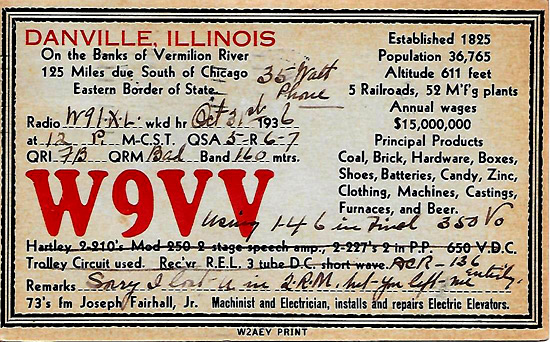

W9VV 1936 Danville, Illinois
Operator: Joseph Fairhall, Jr.
Birth August 24, 1878 in London, England. SK on April 4, 1953
Danville, Illinois.
Joseph Fairhall, Jr. was one of
the pioneer amateurs in the Danville, Vermilion County area. His
earlier call was 9VV. Here is another one of
his 9VV QSL cards.
He also published the article below and two additional articles
for the paper.
First Radio Broadcasting Station Traces Origins
To Early Amateur Operator
By Joe Fairhall Jr. (March 15, 1931, Commercial News)
In the early days of the radio, before it was known by that name and before broadcasting was thought of and when we amateurs referred to the devices with which we were conducting our experiments as wireless and receiving sets,I had the pleasure of meeting on the air a young amateur employed in the meter department of the Westinghouse Electric Manufacturing Company at Pittsburgh, PA. This amateur was one of the first to achieve success in his experiments with the wireless. He was known only as "Old SXK". Conrad spent his evenings sending out messages which were picked up by amateurs in all parts of the country and he soon became one of the most widely wireless men in the country. We used to sit and listen for hours at a stretch to his messages. About this time Dr. Lee Deforest was conducting experiments with the wireless telephone at the national convention of the American Relay Radio League, ARRL, held at the Edge Water Beach Hotel at Chicago. During 1919 one of these instruments was set up and demonstrations consisting of conversations with amateurs in various parts of the city were given.
We were all very much interested in the crude little transmitter designed for wireless communications by voice. If I remember correctly there were at this time only three licensed operators in Danville and they were the only ones possessing wireless receiving sets. It seemed almost unbelievable within the space of ten short years nearly every home in the city now has a radio. Back in those days there was no music on either waves. It was all coded messages amateurs chatting with their friends by the wireless code. About that time amateurs were becoming more and more interested in voice transmissions, making our own apparatus. The amateur operators as a rule does not purchase complete sets.
They usually figure out what they need and make it, which is the most interesting. The writer soon discovered he could make his own transmitter for voice and after considerable testing started to try and send music. An addition phonograph was deployed and a program was arranged. For arranging test he sent out cards to all his brother amateur operators inviting them to listen in, pleased when he received word from several of them that they had heard his program and had enlisted it. For several months the writer broadcasted a musical program from his station every Friday night. An amateur friend at Urbana, Paul Busey, who was working the same lines, also broadcasting musical programs. His station being the only one in the city at the time equipped to broadcasting of this kind. They had great fun listening in on each others programs and offering suggestions.
We had loud speakers in those days but they displayed. He usually gave the familiar signals with his audio horn, which will bring any amateur to a stop, for all amateurs experiment. It is not unusual for a Mystic Night of The Air to make contact and communicate with between ten and thirty stations during an evening. Especially if the air is favorable. Each amateur has supply of official exchange cards and it is customary for them to write and tell you about it if they catch your call. These cards have the station call letters printed on them.
All amateurs prize the cards they receive highly. They come from all of the main districts in the United States, from France, Germany, England and other foreign countries. Vessels at sea, stations on far off islands, and from the most remote places on the globe. No true amateur ever neglects to acknowledge receipt of these cards by mailing one of his own. The walls of many amateur stations are literally pasted with these cards, which are of significant value for they tell the operator who received them, how his signal was heard, the strength of the signal if it faded, whether the reception was good or bad and if static conditions interfered with reception. Then there is the friendly little footnote which makes every amateur feel like he is a close friend of every other Mystic Night of The Air. So it goes on night after night, eighteen thousand amateurs on the lower waves lengths, chatting with each other, exchanging stories, jokes and enjoying the conversation as though they were sitting in the same room. All this is done in the wireless code.
Note: Mr. Fairhall informed the Commercial News that he has received several letters from several Amateur Radio Operators expressing their thanks to this paper for publishing the series of articles on amateur stations. One of these letters came from a Westville amateur operator who states that there are three licensed stations in that town. They are owned by Everett A. Anderson, W9KX, Louis F. Lete, W9AUF and Joseph Dengroce, who's call letters were not given. Mr. Fairhall suggested that amateur radio operators who read this article mail their station cards to the Commercial News. (As you can tell this is quote from an article I received thanks to the Commercial News and the Danville Library.)
QSL, Info KC9UL Collection
Birth, SK date courtesy of W8SU